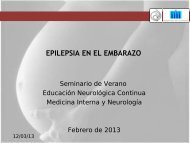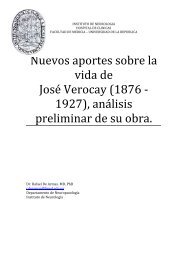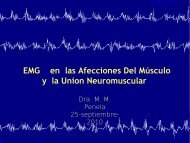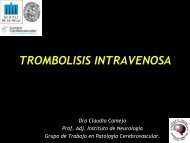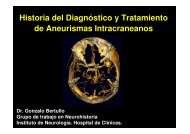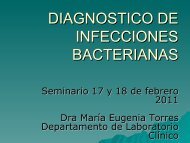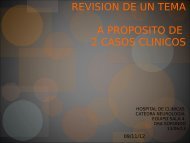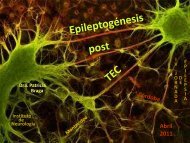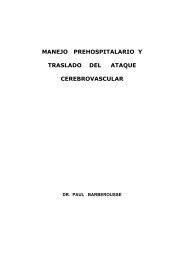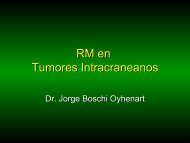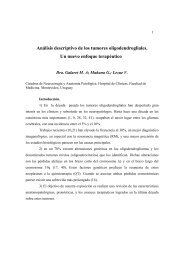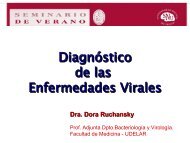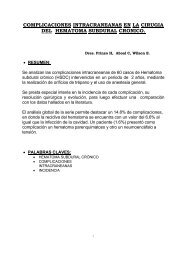© Ricardo Buzó
© Ricardo Buzó - Instituto de NeurologÃ
© Ricardo Buzó - Instituto de NeurologÃ
- No tags were found...
Create successful ePaper yourself
Turn your PDF publications into a flip-book with our unique Google optimized e-Paper software.
<strong>©</strong> <strong>Ricardo</strong> <strong>Buzó</strong>
HOSPITAL de CLINICAS - INSTITUTO de NEUROLOGIA -<br />
PROF. DR. RONALD SALAMANO<br />
FACULTAD DE MEDICINA - UNIVERSIDAD de la REPUBLICA<br />
MONTEVIDEO - URUGUAY<br />
SECCION PARKINSON Y MOVIMIENTOS ANORMALES<br />
DIRECTOR PROF. ADJ. DR. RICARDO BUZÓ<br />
DR. IGNACIO AMORÍN – ASISTENTE
Hiperactividad orbitofrontal externa<br />
izquierda, de la cabeza del caudado<br />
izquierdo, talámica derecha y del<br />
hemisferio cerebeloso izquierdo.<br />
- Hipoperfusión marcada frontal<br />
inferolateral y<br />
orbitofrontal externa derecha.<br />
- Moderado hipoflujo temporal anterior<br />
derecho
« Etude sur une afection nerveuse<br />
caracterisée par l´incordination motrice<br />
accompagnée d´echolalie et de<br />
coprolalie »<br />
GE Gilles de la Tourette<br />
Arch. Neurol. 1885, 9: 19-42 y 158-200
CLINICA
Neurol Neurochir Pol. 2007 Sep-Oct;41(5):381-7. Links<br />
Clinical analysis of Gilles de la<br />
Tourette syndrome based on<br />
126 cases.<br />
Janik P, Kalbarczyk A, Sitek M.<br />
Department of Neurology, ul. Banacha 1a, 02-097 Warsaw, Poland. piotr.janik@am.edu.pl<br />
BACKGROUND AND PURPOSE: Gilles de la Tourette syndrome (TS) is characterized by the presence of multiple<br />
motor and vocal tics, as well as other neuropsychiatric disorders. The aim of the study was to evaluate the<br />
frequency of particular clinical symptoms in patients diagnosed with TS. MATERIAL AND METHODS: A hundred<br />
twenty-six individuals were studied. A brief questionnaire including data from the medical history and<br />
neurological examination was used. RESULTS: TS was much more frequent in males (80%; 101/126) than in<br />
females. The mean age at onset was 7.6 (2-17) years. The onset of the disease was usually slow. Abrupt onset<br />
of the disease, usually after infection, was noted in 11% (12/114) of patients. The mean delay in diagnosis was<br />
3.9 years. In most patients tics were moderate (64%; 81/126). Mild and severe intensity of tics were reported<br />
in 15% (19/126) and 21% (26/126) of patients, respectively. 77% (97/126) of individuals with TS had<br />
comorbidities. The mean comorbidity score was 2.79 per patient. Anger control problems, sleep difficulties,<br />
self-injurious behaviour and coprolalia were strongly associated with comorbidity. The most common reported<br />
comorbidity was attention deficit hyperactivity disorder (59%; 74/126). Family history was positive in 46%<br />
(57/125) of patients, most often in TS patients with onset between ages 2 and 4 years (70%; 14/20).<br />
Haloperidol was the most commonly used medication in our cohort (60%; 57/95). 22% (27/122) of patients did<br />
not receive any symptomatic treatment. CONCLUSIONS: The appropriate diagnosis was delayed for about four<br />
years after the onset of the disease. Comorbidity and behavioural problems were frequent features of TS.<br />
Genetic factors can play an important role in the aetiology of TS.<br />
PMID: 18033637 [PubMed - indexed for MEDLINE]
Mov Disord. 2003 Dec;18(12):1530-3. Links<br />
Premonitory sensory phenomenon in<br />
Tourette's syndrome.<br />
Kwak C, Dat Vuong K, Jankovic J.<br />
Parkinson's Disease Center and Movement Disorders Clinic, Department of Neurology, Baylor<br />
College of Medicine, Houston, Texas 77030, USA.<br />
We administered a questionnaire designed to probe for premonitory sensations associated<br />
with motor tics to 50 patients with Tourette's syndrome (TS). Premonitory sensations were<br />
reported by 46 (92%) patients, and the most common sensation was an urge to move<br />
and an impulse to tic ("had to do it"). Intensification of premonitory sensations, if<br />
prevented from performing a motor tic, was reported also in 37 patients (74%), 36 patients<br />
(72%) reported relief of premonitory sensations after performing the tic, and 27 of 40 (68%)<br />
described a motor tic as a voluntary motor response to an involuntary sensation, rather<br />
than a completely involuntary movement. The "just right" sensation correlated with the<br />
presence of co-morbid obsessive-compulsive disorder. We conclude that<br />
premonitory sensations are an important aspect of motor tics<br />
and some patients perceive motor tics as a voluntary movement<br />
in response to an involuntary sensation.<br />
Copyright 2003 Movement Disorder Society PMID: 14673893 [PubMed - indexed for MEDLINE]
“No son solo Tics y compulsiones de movimientos,<br />
son tics y compulsiones de la percepción, la<br />
imaginación, las pasiones…de toda la<br />
personalidad”<br />
Oliver Sacks
Jankovic J. Tourette's syndrome. New England Journal of Medicine, October 18,<br />
2001; 345:1184-92.
• FIGURE 1. The clinical course of Tourette's syndrome. Onset typically occurs<br />
before seven years of age and the disorder is usually recognized two to<br />
three years after onset. In most children, the severity peaks at nine to 11<br />
years of age. About 5 to 10 percent of patients have an intensifying course<br />
with little or no improvement. In about 85 percent of patients, symptoms<br />
diminish during and after adolescence
ETIOPATOGENIA
Jankovic J.<br />
Tourette's<br />
syndrome. New<br />
England Journal of<br />
Medicine, October<br />
18, 2001; 345:1184-<br />
92.
MODELO<br />
FISIOPATOLOGICO<br />
DEL SINDROME DE<br />
TOURETTE<br />
Y COMORBILIDADES<br />
Modificado de Leckman J,<br />
Cohen D. Evolving Models of<br />
Pathogenesis. en: Leckman J,<br />
Cohen D eds. Tourette<br />
Syndrome: Tics, Obsessions,<br />
Compulsions. New York. Wiley<br />
& Sons 1999.155-176
Circuitos Cortezaganglios<br />
basalestálamo-corteza.<br />
(Adaptado de<br />
Singer.<br />
Neurobiología<br />
Tourette's<br />
Syndrome. En<br />
Jankovic J. ed.<br />
Tourette<br />
Syndrome,<br />
Neurologic Clinics<br />
Philadelphia. WB<br />
Saunders,1997).
This chart shows<br />
subregions of the<br />
brain’s basal<br />
ganglia, which<br />
researchers believe<br />
play a role in<br />
Tourette syndrome.<br />
Anatomical<br />
differences may<br />
help predict who<br />
will continue to<br />
experience<br />
symptoms<br />
throughout their<br />
lives<br />
Jankovic J. Tourette's syndrome. New<br />
England Journal of Medicine, October 18,<br />
2001; 345:1184-92.
Suggested model for the interplay of prefrontal and callosal changes that enhance tic<br />
suppression. Tic suppression is most likely mediated through prefrontal cortical fibers that<br />
ultimately control motor activity through CSTC circuits. Reduced interhemispheric<br />
connectivity may lead to reduced inhibition of prefrontal neurons and thus may facilitate tic<br />
suppression. We suggest that mechanisms of experience-dependent axonal and synaptic<br />
pruning are more pronounced in the CC of those individuals in the TS population who have<br />
been successful in developing the ability to suppress tics, whereas the pruning in the cortical<br />
regions is slowed as a result of continuous activation due to tic suppression<br />
(Plessen et al. Page 14 Eur Child)
J Korean Med Sci. 2002 Aug;17(4):530-6. Links<br />
The segmented regional volumes of the<br />
cerebrum and cerebellum in boys with<br />
Tourette syndrome.<br />
Hong KE, Ock SM, Kang MH, Kim CE, Bae JN, Lim MK, Suh CH, Chung SJ, Cho SC, Lee JS.<br />
Department of Psychiatry, Inha University Hospital and College of Medicine, University, Incheon, Korea.<br />
Neuropathological deficits are an etiological factor in Tourette syndrome (TS), and implicate a network linking the<br />
basal ganglia and the cerebrum, not a particular single brain region. In this study, the volumes of 20 cerebral<br />
and cerebellar regions and their symmetries were measured in normal boys and TS boys by brain magnetic<br />
resonance imaging. Brain magnetic resonance images were obtained prospectively in 19 boys with TS and 17<br />
age-matched normal control boys. Cerebral and cerebellar regions were segmented to gray and white<br />
fractions using algorithm for semi-automated fuzzy tissue segmentation. The frontal, parietal, temporal, and<br />
the occipital lobes and the cerebellum were defined using the semiautomated Talairach atlas-based<br />
parcellation method. Boys with TS had smaller total brain volumes than control subjects. In the gray matter,<br />
although the smaller brain volume was taken into account, TS boys had a smaller right frontal lobe and a larger<br />
left frontal lobe and increased normal asymmetry (left>right). In addition, TS boys had more frontal lobe white<br />
matter. There were no significant differences in regions of interest of the parietal, temporal, or the occipital<br />
lobes or the cerebellum. These findings suggest that boys with TS may have neuropathological abnormalities<br />
in the gray and the white matter of the frontal lobe.<br />
PMID: 12172051 [PubMed - indexed for MEDLINE]
GENETICA
PARACLINICA
Neurology. 2005 Oct 25;65(8):1253-8. Links<br />
Caudate volumes in childhood predict<br />
symptom severity in adults with Tourette<br />
syndrome.<br />
Bloch MH, Leckman JF, Zhu H, Peterson BS.<br />
Child Study Center, Yale University School of Medicine, New Haven, CT, USA.<br />
BACKGROUND: Most children with Tourette syndrome (TS) experience a marked decline in the severity of tic<br />
symptoms during adolescence. Currently no clinical measures can predict whose tic symptoms will persist into<br />
adulthood. Previous cross-sectional imaging studies have identified reduced caudate nucleus volumes in<br />
subjects with TS. OBJECTIVE: To evaluate whether caudate nucleus volumes in childhood can predict the<br />
severity of tic or obsessive-compulsive symptoms at follow-up in early adulthood. METHODS: In a prospective<br />
longitudinal study, clinical status and basal ganglia volumes of 43 children with TS were measured on highresolution<br />
magnetic resonance images before age 14 years. Follow-up clinical assessments were conducted<br />
after age 16 years, an average of 7.5 years later. Linear regression and Tobit regression analyses were used to<br />
assess the association of basal ganglia volumes measured in childhood with the severity of tic and obsessivecompulsive<br />
disorder (OCD) symptoms at the time of childhood MRI and at follow-up in early adulthood.<br />
RESULTS: Volumes of the caudate nucleus correlated significantly and inversely with the severity of tic and<br />
OCD symptoms in early adulthood. Caudate volumes did not correlate with the severity of symptoms at the<br />
time of the MRI scan. CONCLUSIONS: Caudate volumes in children with Tourette syndrome<br />
predict the severity of tic and obsessive-compulsive symptoms in early adulthood.<br />
This study provides compelling evidence that morphologic disturbances of the<br />
caudate nucleus within cortico-striatal-thalamo-cortical circuits are central to the<br />
persistence of both tics and obsessive-compulsive symptoms into adulthood.<br />
PMID: 16247053 [PubMed - indexed for MEDLINE] PMCID: PMC2367161
SPECT CEREBRAL<br />
SPECT cerebral de los 5 pacientes. Intensa hiperactividad de la cabeza del núcleo<br />
caudado izquierdo en los pacientes 4 y 5. Hiperactividad de ambos putámenes en<br />
el paciente 3. Hiperactividad orbitofrontal en 2, 3 y 4, y del cíngulo anterior en 1, 2<br />
(no se muestra) y 3. Asimetrías talámicas en 2 y 5. Hipoflujo del putamen derecho,<br />
ínsula, corteza temporal y orbitofrontal izquierda en el paciente 1.<br />
ABORDAJE NEUROPSIQUIATRICO<br />
DEL SINDROME DE GILLES DE LA TOURETTE<br />
(Ventura, R., <strong>Buzó</strong>, R., de Medina O., Dieguez, E.M., Bocchino, S., Ferrando, R., Aljanatti, R.,Raggio,<br />
V.E., Amorín, I., Salinas, D.)<br />
Sección Enfermedad de Parkinson y Movimientos Anormales del Instituto de Neurología. Hospital de Clínicas Facultad de Medicina
GILLES DE LA TOURETTE<br />
↑ estriado, orbitofrontal, cíngulo anterior, ínsula.
TRATAMIENTO
Jankovic J. Tourette's<br />
syndrome. New<br />
England Journal of<br />
Medicine, October 18,<br />
2001; 345:1184-92.
Stereotact Funct Neurosurg. 2008;86(2):87-91. Epub 2007 Dec 12. Links<br />
Microelectrode-guided deep brain stimulation for<br />
Tourette syndrome: within-subject comparison of<br />
different stimulation sites.<br />
Shields DC, Cheng ML, Flaherty AW, Gale JT, Eskandar EN.<br />
Department of Neurosurgery, Massachusetts General Hospital and Harvard Medical School, Boston, Mass., USA.<br />
BACKGROUND: As medical therapy for Tourette syndrome (TS) is ineffective in a<br />
small subset of patients, surgical interventions, including deep brain<br />
stimulation at various sites, have been developed in recent years. CASE<br />
DESCRIPTION: We present the case of a 40-year-old woman with TS whose<br />
severe tics had caused unilateral blindness. Despite trials of more than 40<br />
medications, her symptoms improved significantly only after placement of<br />
bilateral deep brain stimulators in the anterior inferior internal capsule.<br />
However, symptomatic improvement was not complete, and her electrode<br />
connections eventually became permanently damaged by the remaining<br />
retrocollic jerks. She underwent removal of the internal capsule electrodes<br />
and placement of centromedian nucleus thalamic stimulators with significantly<br />
improved tic control. CONCLUSION: Whereas the anterior internal capsule site<br />
had also produced psychiatric side effects such as altered mood and impulse<br />
control, the thalamic site has not done so to date. Thus, distinct surgical<br />
targets for TS may be appropriate for patients with specific comorbidities. (c)<br />
2007 S. Karger AG, Basel<br />
PMID: 18073521 [PubMed - indexed for MEDLINE]
“Cualquier descubrimiento sobre Tourette<br />
ampliará sin duda enormemente nuestra<br />
comprensión de la naturaleza humana en<br />
general…No conozco ningún otro Síndrome<br />
que posea un interés comparable”<br />
Alexander R. LURIA



